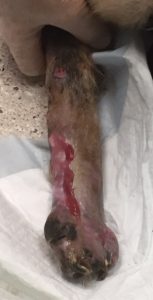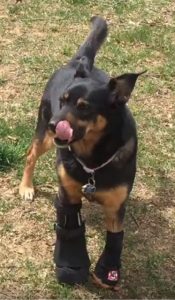By: Clayton Blunk, My Pet’s Brace Practitioner
The Patient: Nya, a five-year-old, 50-pound, Shepherd mix that was hit by a car.
Case of Interest: Over 80% of our business is providing stifle braces for Cranial Cruciate Ligament injuries. However, we also fabricate carpal, hock, and elbow braces for multiple etiologies. In special cases, we are brought onto a case in collaboration with orthopedic specialists for a non-standard brace.
Nya was hit by a car in mid-2018. After being stabilized by an emergency department in Maryland, the initial prognosis was that Nya would not be able to save both of her forelimbs. She was transferred to the University of Pennsylvania to attempt to save her legs. My Pet’s Brace becomes involved in the case at the end of December 2018 to make a special carpal support brace.
Diagnostic History: In mid-2018, Nya was hit by a car. Eventually, after multiple procedures, her right forelimb needed to be placed in an external fixator. In December, the fixator was removed. Diagnostic imaging after the fixator was removed showed promising stability, but there were still considerable open wounds that needed managing and protecting. While Nya was still sedated, her condition was evaluated and her medical team at the University of Pennsylvania determined that she would benefit from a carpal brace.
Nya presented to My Pet’s Brace limping and in a splint. We made a cast of Nya’s forelimb from the paw to just distal to the olecranon. This cast was then used to create a custom-made, non-jointed carpal brace. This brace was made with a closed-cell foam interior and a hard-medical grade plastic exterior. Special consideration was given to the bony areas where the pins from the fixator were located. It was important to unload those areas to allow them to heal. Additionally, Nya did not have a normal weight-bearing surface because of the position her limb was fixed. Nya’s brace was designed to have extra padding to prevent excessive pressure on her toes as well as widen the base of support for her paw.
Follow-Ups: Nya was seen approximately 1 month and 3 ½ months post-delivery. At each of the follow-up appointments, her condition was evaluated and straps were replaced as necessary. At Nya’s first recheck, her swelling had reduced significantly so padding was added to the inside of the device to tighten the fit of the brace. The owners reported that she was able to ambulate well and the brace was helping effectively manage her wounds because of the ease of removing the brace and cleaning the limb. By early April 2019, her wounds had entirely healed and her team at UPenn cleared her for a return to normal activity with the brace. Her owners report she can keep up with their new puppy. We will continue to follow up with Nya’s progress as she continues to recover from such a traumatic event. She is a happy dog who will be able to enjoy life as a normal dog for years to come.


